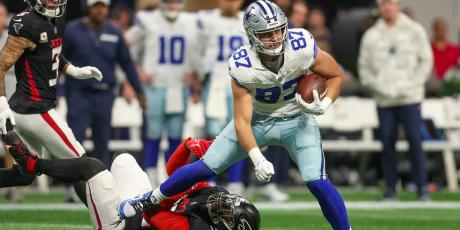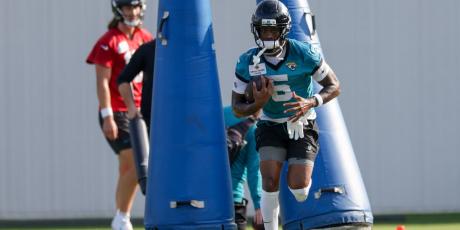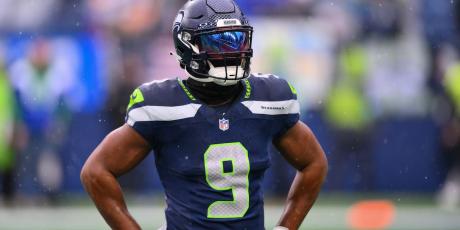Is the Rookie Running Back Wall Real?

There’s a narrative in football that says because rookies have never played a 16 game NFL season before, that a first year player who sees a heavy workload is likely to break down, both physically and mentally, by year’s end.
This narrative especially follows rookie running backs, since backs drafted early are expected to see a full workload right away and are at the skill position that takes the most pounding. By comparing rookie running back production down the stretch to that of their veteran counterparts, we can get an idea as to whether or not rookies really do hit a proverbial wall late in the year.
Editor's Note: Early bird rates for our 2016 subscription packages are available NOW! Sign up HERE!
Methodology
Because this study is meant to see how players perform down the stretch after a relatively heavy early season workload, rather than picking players based on end of season totals, backs that saw at least 150 touches through their team’s first 12 games were examined here. Going back to the 2000 season, this yielded a sample of 44 rookies and 415 veterans.
By analyzing games played and production in the final quarter of the season against stats in the first three quarters of the season, we can see if, across a variety of metrics, first year backs do in fact fall off late in the season compared to veteran workhorses.
Rookie Running Backs
| % Team Games | Touches/Gm | Total Yds/Gm | RushAtt/Gm | Yds/Touch | Yds/Ru | PPR FP/Gm | |
|---|---|---|---|---|---|---|---|
| AVG % Change | -11.4% | 5.8% | 4.3% | 8.2% | -2.1% | 0.9% | 10.4% |
| % of Players Increased | 25.0% | 56.8% | 52.3% | 54.5% | 43.2% | 47.7% | 59.1% |
| % of Players Decrease | 31.8% | 43.2% | 47.7% | 45.5% | 56.8% | 52.3% | 40.9% |
| % No Change | 43.2% |
Fourteen of the 44 rookies in this sample played a fewer portion of their team's games in the last quarter of the season than they did for the first 12 games, but the vast majority of rookie backs remained active throughout the season or were active even more often than they were early on in the year. Even though the average rookie workhorse back saw a slight dip in percent of team games played late in the year, rookies improved in every category except for yards per touch in the final quarter of the season.
To make sure that the averages weren’t skewed by any huge late season outliers, the percent of players that increased or decreased in each category reinforces the results of the average percent change in those categories. Only the efficiency metrics (yards per touch and yards per rush) saw the majority of rookies regress late in the season.
Veteran Running Backs
| % Team Games | Touches/Gm | Total Yds/Gm | RushAtt/Gm | Yds/Touch | Yds/Ru | PPR FP/Gm | |
|---|---|---|---|---|---|---|---|
| AVG % Change | -9.8% | -11.2% | -10.1% | -9.6% | -5.7% | -5.1% | -11.2% |
| % of Players Increased | 21.4% | 40.7% | 40.0% | 44.1% | 45.8% | 45.1% | 39.3% |
| % of Players Decrease | 27.2% | 59.3% | 60.0% | 55.9% | 54.2% | 54.9% | 60.7% |
| % No Change | 51.3% |
Like rookies, the average running back will miss a late season game or two at some point, but most see no change in percent of games in which they are active. Unlike rookies though, veterans saw a significant drop off in every statistical category in the final quarter of the regular season.
While this may look alarming for veterans, it should be noted that the sample includes 29 players that suffered season ending injuries after reaching the 150 touch mark. While this does factor into how running backs hold up, it’s worth looking at the data for players that did stay active, since season ending injuries are often a fluky occurrence.
| % Team Games | Touches/Gm | Total Yds/Gm | RushAtt/Gm | Yds/Touch | Yds/Ru | PPR FP/Gm | |
|---|---|---|---|---|---|---|---|
| AVG % Change | -3.0% | -4.5% | -3.4% | -2.9% | 1.4% | 2.0% | -4.6% |
| % of Players Increased | 23.1% | 43.8% | 43.0% | 47.4% | 49.2% | 48.4% | 42.2% |
| % of Players Decrease | 21.8% | 56.2% | 57.0% | 52.6% | 50.8% | 51.6% | 57.8% |
| % No Change | 55.2% |
Even after removing players whose season ended early, veteran running backs still saw a slight decline in every production category except for efficiency metrics. Again, the percent of players that increased and decreased in each category reiterates the findings of the average percent change in stats for veterans.
Age didn’t seem to play a major role in determining which veterans produced better late in the season. Including season ending injuries, the average age of backs that increased their fantasy production in the final four games was 26.2, while those that saw a dip in per game fantasy points had an average age of 26.5.
The Bottom Line
There is no statistical evidence that suggests that rookie running backs hit a wall late in the season. The numbers suggest that their overall production tends to go up, even though their efficiency takes a slight dip. A shoehorned narrative is that these first year studs have proven that they can be the workhorses that they were drafted to be and that teams are doing nothing to limit the first year players late in the season, and might even be putting more responsibility on their shoulders down the stretch.
While veterans might be slightly better conditioned than rookies, which may explain the small uptick in efficiency, this number looks to be skewed by a couple late season anomalies, since the majority of veterans still see some decrease in efficiency.
The rookie wall looks to be nothing more than a myth and there is even evidence that rookie backs who were drafted to shoulder the load will see an increase in production late in the year, and may even perform better down the stretch than veterans.
What This Means for Fantasy Football in 2016
Ezekiel Elliott is the most obvious impact rookie this season, and regardless of what you think is a fair price for the newest Cowboy, Elliott should not drop in your rankings simply based on the premise of a late season decline.
While no other rookie backs are expected to be the majority shareholders of touches for their respective backfields, if a player like Kenyan Drake or C.J. Prosise emerges as a lead back early in the year, they should be added to fantasy rosters with no worry of an end of season fall off.




















